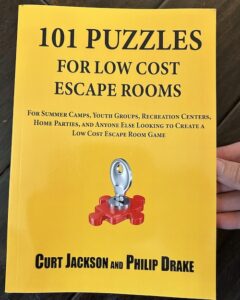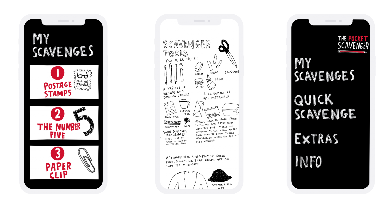<< Back to EBOW overview
DIY Books for ordinary people? Yes, please (not textbooks or academic books). We started this list to explore what might be out there. Some are favorites, others illustrate how the space is emerging – or to reveal hidden roots in outdoor play. This is not a lit review for academic concept building, or expert industry guides, so much as a collection for practitioners.
Have ideas? Please contact us and we’ll see about adding them here. Our list is certainly just a starting point and there are so many things to add!
Mandatory self promotion (an exception): Our book, Locally Played, is a great foundation for the concepts – like a way to think about games and stronger places, or so we think! That said, many of the case studies in the first chapters are a bit fancy and/or expensive — so grab the concepts up top, and then jump to the later chapters for more DIY innovations and emerging forms.
The Pocket Scavenger, by Keri Smith (2013)

For consumers – especially kids – this is a wonderful DIY notebook to lead you on an extended outdoor scavenger hunt. With a light introduction, most pages have space for writing your own notes – led by guides for specific objects and concepts to explore. Our love for game design really appreciates the books’ celebration of randomness as a tool of creativity, inquiry and opening one’s eyes anew. The book is also anchored in some of the history of arts and outdoor education. Feels especially useful for ages 7-14, but could easily be embraced by adults as well. Find a copy at a library near you using WorldCat or on Bookshop.org
An app was spun out of the book (per the developer), with a much shorter lifespan: it was gone by 2024, perhaps much earlier. This is a good reminder of how the lifespan of books print often long outlasts the digital version.
The Do-It-Yourself Escape Room Book

“A Practical Guide to Writing Your Own Clues, Designing Puzzles, and Creating Your Own Challenges” by Paige Ellsworth Lyman, 175 pages, 2021, from Simon and Schuster. Get it via WorldCat or via BookShop.org.
This wonderful book is primarily about traditional puzzle rooms, but does provide some guidance for more narrative approaches that could center on local history, identity and building community. Most importantly, the do-it-yourself approach is accessible.
Excerpt: “TIP: If you’re drawing from history, try customizing your theme to your own city or town” (page 3).
101 Puzzles for Low Cost Escape Rooms.

by Philip Drake and Curt Jackson. Independently published in 2019.
Each page contains a different puzzle type, with a lock indicating the difficulty level. There is very little on narrative or impact, but for traditional escape room puzzle types, this can be a handy quick reference.
More things to come
(Again, these must be more than academic analysis — they have to offer guides for making things.)
- Grow-A-Game cards
- Rory’s Story Cubes
- Boal, A. (2002). Games for Actors and Non-Actors (A. Jackson, Trans.; 2nd edition). Routledge.
- Lydon, M., Garcia, A., & Duany, A. (2015). Tactical Urbanism: Short-term Action for Long-term Change. Island Press.
Have ideas? Please contact us and we’ll see about adding them here. Our list is certainly just a starting point and there are so many things to add!
